Use Office Color Psychology to Inspire Employees
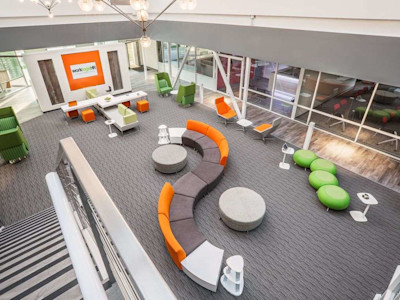
If you asked your employees to share their favorite color, what would most choose? With almost certainty, we can guess the color choice is not brown, grey, or white. Further, a recent poll conducted by YouGov looked at data from 10 different countries and white and brown were ranked at the bottom across the board. Grey didn't even make the list. However, if you walk through many offices across the country, these colors dominate the modern office furniture design color palette.
Whether it is consciously or not, color evokes an emotional response and affects mood and productivity in all humans.
Colors possess the power to evoke meaning and elicit emotions. Although personal preferences play a role, many reactions stem from physical and mental responses. In the context of office colors, brown, grey, and white dominate. It is advantageous to consider the associations and emotions linked to these colors while contemplating office color psychology principles. By integrating these principles into your modern office furniture design, you can actively create an environment that fosters productivity and well-being. Brown is not a color that stands out. It is a hue that blends into the crowd, while grey is considered unresponsive and conforming. White can bring calmness, comfort, and hope, however, too much of it can evoke emptiness and isolation. There is more to choosing colors for your workspace than matching your logo. Expand your office color palette and consider color psychology and how you can use it to bring out the best in your team.
Office Color Psychology
Whether it is consciously or not, color evokes an emotional response and affects mood and productivity in all humans. Colors have been known to cause an actual physical response, like lowering your blood pressure or suppressing your appetite. It has been shown that some of these reactions are learned, but the fact that color has an effect on us all can't be denied. Unconscious or otherwise, color can evoke emotions, inspire reactions, and change modes of thinking. It can excite or soothe your mood, raise or lower your blood pressure, and even whet your appetite! Whether it’s innate or learned, it’s undeniable that color has a vital impact on how we go about our lives.
Research reveals people make a subconscious judgment about a person, environment, or product within 90 seconds of initial viewing and that up to 90% of that assessment is based on color alone.
Here are some colors to consider bring to your organization, and some of the emotions and effects associated with each.
Red
Red, renowned for its energizing properties and ability to increase heart rate, enhances confidence and instills a sense of power within your team. Conference rooms and meeting spaces particularly benefit from the presence of red. After all, who wouldn't want to infuse energy into a finance meeting or exude power during a presentation? Incorporating the color red into such settings amplifies the impact and leaves a lasting impression.
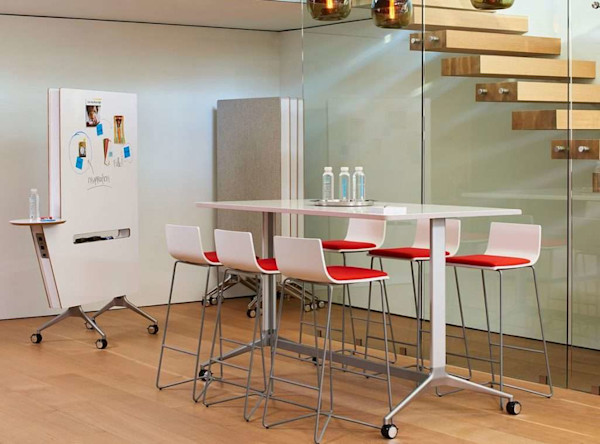
Blue
Frequently characterized as peaceful, tranquil, and orderly, blue presents a range of advantages. Research indicates that blue has the ability to lower blood pressure and slow down the heart rate. Its calming and organized characteristics position it as one of the top colors for boosting productivity. Furthermore, blue is strongly linked to trust and dependability. When contemplating office color psychology, integrating blue into your office design nurtures a sense of trust and reliability. This holds particular benefits in reception areas, where new employees or clients form their initial impressions. Opting for blue as a dominant and influential color choice allows you to establish a welcoming and trustworthy environment.
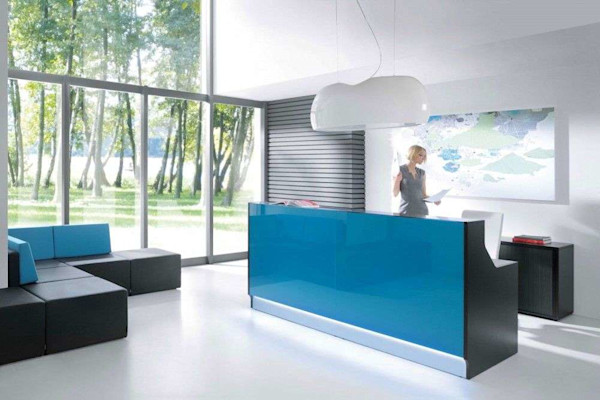
Purple
Purple often serves as an inspiration for creativity. Furthermore, due to its blue shades, it can also act as a calming color, contributing to lowering blood pressure and heart rate. Purple strikes a perfect balance, blending the qualities of blue and red. It encompasses relaxation and stability while incorporating the energy of red, resulting in a sense of wisdom and good judgment. By incorporating purple into your modern office cubicle design, you achieve an ideal blend of energy and stress reduction, creating a harmonious and conducive workspace.
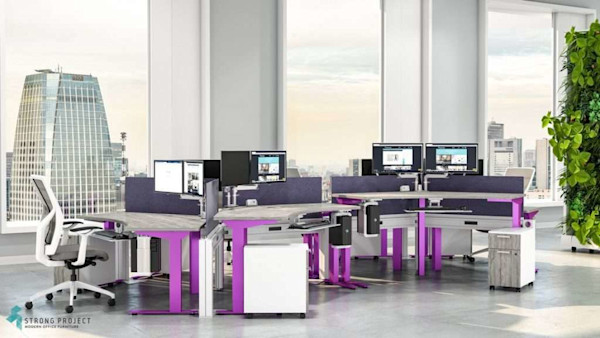
Green
Among all the colors, green stands out as the most restful and relaxing color. It embodies harmony, tranquility, and peace. Opting for green can enhance stability, endurance, growth, and a sense of renewal. By incorporating green elements into your office, particularly through natural elements like plants, you can reap numerous benefits. So, when considering office color psychology, consider adding touches of green to your modern office layout to harness its relaxing effects.
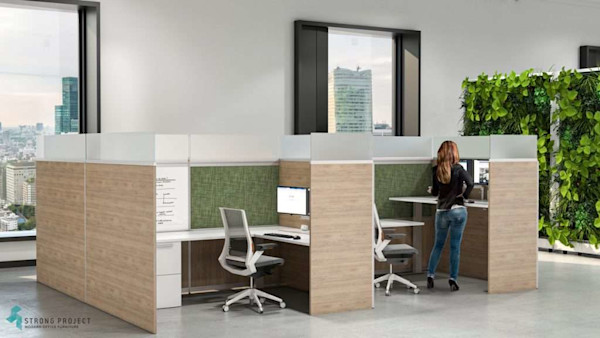
Orange
Orange is a social color. Incorporating orange into your office enhances communication. This is an excellent color for learning new things and inspiring new ideas. Does your office need excellent teamwork to thrive? Consider incorporating orange in your palette. When creating a space to foster creativity, conversation and collaboration consider using orange. This collaborative seating series took inspiration from architecture and landscapes to create a graceful, inviting form that evokes a sense of beauty and peace without sacrificing warmth. Create a space for your team to engage and create.
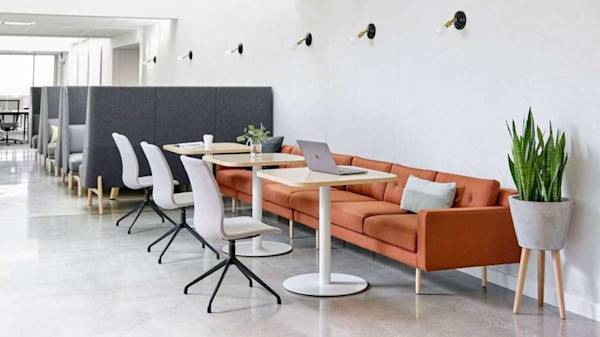
Yellow
When considering office color psychology, this color may offer the most positive benefits of all. Yellow, associated with intellect and logic, enhances analytical thinking. It also inspires optimism, happiness, and enthusiasm, fostering innovation and problem-solving. Surrounding oneself with yellow triggers the release of serotonin, the chemical behind happiness. Incorporating yellow into modern office furniture design can have a positive impact on your team's productivity.
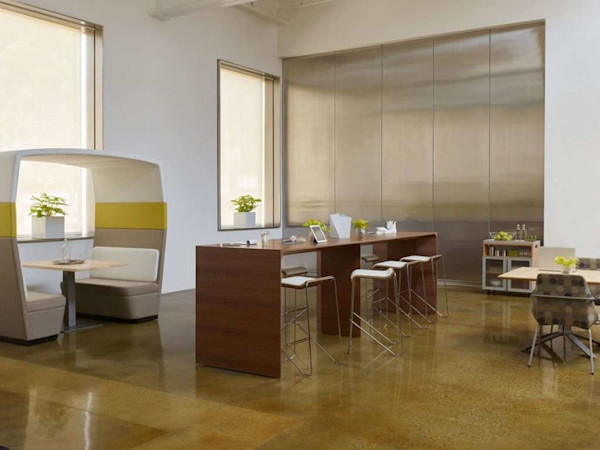
Bringing Color into Modern Office Furniture Design
Bringing color into your office doesn't have to be an overwhelming or overarching commitment to just one color. Find a complementary office color palette that will fit your company brand and accomplish the office color phycology goals set for each segment of your office. According to research, within 90 seconds of initial viewing, people form a subconscious judgment about a person, environment, or product, with up to 90% of that assessment being attributed to color alone. To leverage the power of office color psychology and leave a lasting impression on your clients, consider incorporating small accents of color into your modern office furniture design. By doing so, you can strategically utilize the impact of color to make a positive and memorable impression. At StrongProject we can help bring color into your office with our modern office furniture design. These Famous Brands Can Inspire Your Own Office Colors How to Bring Focus to the Open Office Workplace



